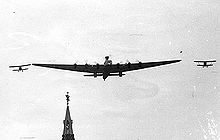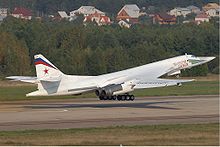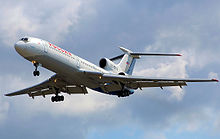Tupolev - Picture

|
|
Tupolev
Industry: Aerospace and defense
Founded: 1922
Headquarters: Moscow, Russia
Products: Commercial airliners
Military aircraft
Parent: United Aircraft Corporation
Website: Tupolev.ru
Tupolev (Russian: ТÑÌполев, IPA: [ËtupÉlʲɪf]) is a Russian aerospace and defence company, headquartered in Moscow. Known officially as Public Stock Company Tupolev, it is the successor of the Tupolev OKB or Tupolev Design Bureau (OKB-156, design office prefix Tu) headed by the Soviet aerospace engineer A.N. Tupolev. The company celebrated its 80th anniversary on October 22, 2002. The Russian government is planning to merge Tupolev with Mikoyan, Ilyushin, Irkut, Sukhoi, and Yakovlev as a new company named United Aircraft Corporation.
Introduction
The capabilities of PSC Tupolev include development, manufacturing and overhaul for both civil and military aerospace products such as aircraft and weapons systems. It is also active with missile and naval aviation technologies. More than 18,000 Tupolev aircraft were produced for the USSR and the Eastern Bloc.
History
Tupolev OKB was founded by Andrei Nikolayevich Tupolev during 1922. Its facilities are tailored for aeronautics research and aircraft design only, manufacturing is handled by other firms. It researched all-metal airplanes during the 1920s.

Picture - Tupolev ANT-20 Maxim Gorky, the largest airplane of the 1930s, was used for Stalinist propaganda.
Among its notable results during the period was the heavy bomber, where Tupolev's design approach defined for many years the trends of heavy aircraft development, civil and military.
During World War II, the twin-engined, all-metal Tu-2 was one of the best front-line bombers of the Soviets. Several variants of it were produced in large numbers from 1942. During the war it used wooden rear fuselages due to a shortage of metal.
During 1945, three Boeing B-29 Superfortresses landed in Soviet territory after missions over Japan. They were quickly copied by the design bureau and formed the basis of the first Soviet intercontinental strategic bomber, the Tu-4, which first flew during 1947 and was produced in substantial numbers.
This was succeeded by the development of the jet-powered Tu-16 bomber, based on an enlarged version of the B-29/Tu-4 fuselage, which used a sweptback wing for good subsonic performance.
As turbojets were not fuel efficient enough to provide truly intercontinental range, the Soviets elected to design a new bomber, the Tu-20, more commonly referred to as the Tu-95. It, too, was based on the fuselage and structural design of the Tu-4, but with four colossal Kuznetsov NK-12 turboprop engines providing a unique combination of jet-like speed and long range. It became the definitive Soviet intercontinental bomber, with intercontinental range and jet-like performance. In many respects the Soviet equivalent of the Boeing B-52 Stratofortress, it served as a strategic bomber and in many alternate roles, including reconnaissance and anti-submarine warfare.
The Tu-16 was developed into the civil Tu-104, which was for some time the only jet-powered airliner due to the temporary grounding of the De Havilland Comet. The Tu-95 became the basis of the unique Tu-114 medium-to-long-range airliner, the fastest turboprop aircraft ever. One common feature found in many large subsonic Tupolev jet aircraft is large pods extending rearward from the trailing edge of the wings, holding the aircraft's landing gear. These allow the aircraft to have landing gears made up of many large low-pressure tires, which are invaluable for use on the poor quality runways that were common in the Soviet Union at the time. For example the Tu-154 airliner, the Soviet equivalent of the Boeing 727, has 14 tyres, the same number as Boeing's far larger 777-200.
Even before the first flights of the Tu-16 and Tu-20/Tu-95, Tupolev was working on supersonic bombers, culminating in the unsuccessful Tu-98. Although that aircraft never entered service, it became the basis for the prototype Tu-102 (later developed into the Tu-28 interceptor) and the Tu-105, which evolved into the supersonic Tu-22 bomber during the mid-1960s. Intended as a counterpart to the Convair B-58 Hustler, the Tu-22 proved rather less capable, although ironically it remained in service much longer than the American aircraft. Meanwhile the "K" Department was formed in the Design Bureau, with the task of designing unmanned aircraft such as the Tu-139 and the Tu-143 unmanned reconnaissance aircraft.

Picture - Tu-144 supersonic airliner
During the 1960s A. N. Tupolev's son, A. A. Tupolev, became active with management of the agency. His role included the development of the world's first supersonic airliner, the Tu-144, the popular Tu-154 airliner and the Tupolev Tu-22M strategic bomber. All these developments enabled the Soviet Union to achieve strategic military and civil aviation parity with the West.
During the 1970s, Tupolev concentrated its efforts on improving the performance of the Tu-22M bombers, whose variants included maritime versions. It is the presence of these bombers in quantity that brought about the SALT I and SALT II treaties. Also the efficiency and performance of the Tu-154 was improved, culminating in the efficient Tu-154M.
During the 1980s the design bureau developed the supersonic Tu-160 strategic bomber. Features include variable-geometry wings.
Post Soviet Era
With the end of the Cold War, research work was concentrated on subsonic civil aircraft, mainly on operating economics and alternative fuels. The developments include fly-by-wire, use of efficient high-bypass turbofans and advanced aerodynamic layouts for the 21st century transport aircraft such as the Tu-204/Tu-214, Tu-330 and Tu-334.
Among current Tupolev projects:
further development of Tu-204/214 and TU-334 aircraft family
development of cargo aircraft Tu-330, regional and executive Tu-324 aircraft
research on practical aspects of aircraft operation using alternative fuels
modernization of Russian Naval Aviation and Air Force
On 19 August 2009, Tupolev announced that it had a contract with the Russian Defense Ministry to develop a new-generation strategic bomber which "will be a conceptually new plane based on the most advanced technologies".
Directors
Andrei Nikolayevich Tupolev was a major designer at the Moscow-based Central Aero-Hydrodynamic Institute (TsAGI) from 1929 until his death in 1972. This design bureau produced mostly bombers and airliners.
Alexei Andreyevich Tupolev, son of Andrei Tupolev, was also a famous aircraft designer. His most famous design was the supersonic airliner Tupolev Tu-144. He managed Tupolev until his death during 2001.
Tupolev aircraft
Many designs were developed by the design bureau. Those in production series may manufacture as many as 4,500 units as for the Tu-2. However many are also dead-ends or experimental, with as little as a single copy being produced. They were terminated by changing military or political situations. Many of these experimental variants enabled series production versions.
Early piston-powered
ANT-1 - The first aircraft by A.N.T. and the first Soviet-built aircraft. Mixed materials design. The work started during 1921. Assembly began in 1922. The tests were cancelled due to engine malfunction.
ANT-2 - Two passenger aircraft. The first Soviet all-metal aircraft, 1924.
ANT-3/R-3 - All-metal two-seats recce biplane, 1925. About 100 were built.
ANT-3 Pervenets - torpedo boat (not an aircraft!). It was put afloat 14 March 1928.
ANT-4/TB-1 - All-metal twin-engined (M-17B) monoplane heavy bomber, 1929. There were 212 aircraft built. There was a G-1 cargo version.
ANT-5/I-4 - Prototype of I-4 fighter. The first aircraft designed by Pavel Sukhoi, 1927. 369 were built. I-4 was in service in 1928-1933.
ANT-6/TB-3 - Four-engine development of TB-1, 1930. There was a G-2 cargo version.
ANT-7/R-6/KR-6/MR-6 - Development of TB-1 as reconnaissance (R-6), "cruiser" (escort fighter, KR-6), and maritime patrol/torpedo bomber (MR-6), 1929.
ANT-8/MDR-2 - Maritime long range recce flying boat, 1931.
ANT-9 - Three-engined passenger airliner, 1931.
ANT-10/R-7 - Reconnaissance/light bomber aircraft prototype, 1930.
ANT-13/I-8 - Fighter/interceptor prototype, 1929.
ANT-14 Pravda - Large five-engined propaganda monoplane, 1931.
ANT-16/TB-4 - Six-engine version of TB-3, predecessor of ANT-20, 1933.
ANT-20 Maxim Gorky - Eight-engine huge cargo/propaganda aircraft, 1934.
ANT-21/MI-3 - Multiseat fighter. Development of R-6, 1932.
ANT-22/MK-1 - Armoured six-engine recce flying boat, 1934.
ANT-23/I-12 - Experimental twin-engined fighter equipped with two recoilless 75mm cannons, 1931.
ANT-25 - Single engine monoplane long range bomber. Designed by Pavel Sukhoi. ANT-25RD (RD for "Rekord Dalnosty", i.e. "Range Record") was used in a record flight from Moscow to San Jacinto, California, USA over the North Pole - 10148 km, 1933 (one was built in 1989).
ANT-27/MTB-1 - Patrol flying-boat for the Soviet Navy, 1934.
ANT-26/TB-6 - 12-engined heavy-bomber aircraft project.
ANT-31/I-14 - All metal monoplane fighter, 1935.
ANT-35/PS-35 - Twin-engined passenger transport aircraft, 1936.
ANT-36/DB-1 - Long-range bomber, 1936.
ANT-37/DB-2 - Long-range bomber, 1935.
ANT-40/SB/PS-40/PS-41 - Medium bomber, also erroneously known as SB-2, 1936.
ANT-44/MTB-2 - Heavy-bomber flying-boat, 1937.
Tu-2 (ANT-58/ANT-61) "Bat" - Medium bomber, 1939.
Tu-4 "Bull", copied from seized Boeing B-29 Superfortresses. Initial name is B-4 (The A.N.T. want not give his name to the aircraft designed outside of his OKB), 1947.
Tu-10 (ANT-68) - General-purpose bomber prototype, developed from the Tu-2.
Experimental aircraft
Tu-1 (ANT-63P) - prototype night-fighter variant of the Tu-2, 1947
Tu-6 - prototype reconnaissance variant of the Tu-2
Tu-8 (ANT-69) - prototype long-range bomber variant of the Tu-2
Tu-12 (also known as the Tu-77) - medium bomber prototype, 1947
Tu-70 - prototype airliner variant of the Tu-4, 1946
Tu-72
Tu-73
Tu-74
Tu-75 - prototype cargo/transport variant of the Tu-4, 1950
Tu-80 - prototype long-range variant of the Tu-4, 1949
Tu-82 - experimental swept-wing jet bomber, 1949
Tu-85 "Barge" - prototype strategic bomber variant of the Tu-4, 1951
Tu-91 "Boot" - prototype naval attack aircraft, 1955
Tu-93
Tu-96 - prototype long-range intercontinental high altitude strategic bomber variant of the Tu-95, 1955
Tu-98 "Backfin" - prototype swept-wing jet bomber, 1956
Tu-102 - development test variant of the Tu-28, 1959
Tu-105 - initial prototype of the Tu-22, 1954
Tu-107 - prototype military transport variant of the Tu-104
Tu-110 "Cooker" - prototype long-range airliner, 1957
Tu-114 - prototype airliner variant of the Tu-95, entered production
Tu-116 - two Tu-95's fitted with passenger cabins
Tu-119 - prototype nuclear reactor-powered variant of the Tu-95
Tu-125 - proposed long-range supersonic bomber
Tu-155
Tu-156
Tu-206 - a Tu-204 converted into a testbed for alternative fuels
Tu-216
Bombers and other military types

Picture - Tu-160, the last of the Soviet bombers
Tu-14 "Bosun"
Tu-16 "Badger"
Tu-20/Tu-95 "Bear" long-range strategic bomber and modifications
Tu-142 "Bear F/Bear J", anti-submarine
Tu-22 "Blinder"
Tu-22M/Tu-26 "Backfire"
Tu-126 "Moss" airborne early warning and control aircraft variant of the Tu-114
Tu-160 "Blackjack" supersonic swing-wing bomber
Interceptors
Tu-28/Tu-128P "Fiddler"
Airliners/transport

Picture - Tupolev Tu-154M.
Tu-104 "Camel"
Tu-114 Rossiya "Cleat"
Tu-124 "Cookpot"
Tu-134 "Crusty"
Tu-144 "Charger" a supersonic airliner similar to Concorde
Tu-154 "Careless"
Tu-204 a narrow-body jet airliner
Tu-214, Tu-204-200's built at a different factory
Tu-244, an SST concept developed from the Tu-144
Tu-324, a regional airliner concept
Tu-330, medium transport aircraft based on the Tu-204/Tu-214
Tu-334, a short haul jet airliner
Tu-444, a supersonic business jet concept.
Unmanned aircraft
Tu-121C
Tu-123 Yastreb-1
Tu-139 Yastreb-2
Tu-141 Strizh
Tu-143 Reis
Tu-243 Reis-D
Tu-300 Korshun
Planned aircraft
PAK DA
Tu-2000
List of aircraft
List of military aircraft of the Soviet Union and the CIS
Tupolev Pictures and Tupolev for Sale.
Living Warbirds: The best warbirds DVD series.
Source: WikiPedia